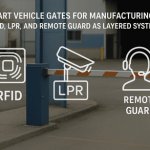
Summer isn’t just about sunshine and slower schedules—in the commercial property world, it’s peak season for office turnover.
As leases end, new tenants move in, and spaces sit temporarily empty, building security becomes more complex. With so many people—vendors, movers, brokers, painters, contractors—coming and going, it’s easy for access control to fall through the cracks.
At SSP, we work with property managers and owners who want to keep their buildings secure during transitions—without disrupting the flow of business. Here's what you need to know about managing building access during tenant changes and suite vacancies.
l
l
Why Summer Turnover Increases Security Risks
Tenant turnover introduces several challenges all at once:
-
Old credentials may still be active (former tenants, subtenants, cleaning crews)
-
New vendors and movers need temporary access
-
Vacant suites become targets for trespassing, copper theft, or vandalism
-
Construction or retrofitting creates blind spots and unlocked doors
With more activity and less control, the risk isn’t just security breaches—it’s lost accountability.
l
l
🛡️ 1. Audit All Active Credentials (Before and After Each Move)
When a tenant moves out, you don’t just need their keys—you need to deactivate all associated access credentials, including:
-
Badges and fobs
-
Mobile credentials
-
Elevator or suite-specific permissions
-
Shared-area access (storage, loading docks, shared restrooms)
Tip: Do a credential audit 2–3 weeks before move-out, and again post-departure to ensure all digital access points are locked down.
l
l
🔐 2. Assign Time-Limited Access to Movers and Vendors
Moving trucks and vendor crews don’t need 24/7 access—they need it for 2 days, tops.
Use your access control system to:
-
Grant temporary badges that expire automatically
-
Limit access to specific doors, floors, or elevators
-
Track who enters and when via digital logs
This not only improves security, but also reduces liability if damage occurs during the move.
l
l
🚪 3. Secure Vacant Suites Immediately
An unoccupied office may look harmless, but it’s vulnerable to:
-
Theft (copper, wiring, leftover IT hardware)
-
Vandalism
-
Unauthorized occupancy
-
Utility abuse (HVAC left running, lights on)
What to do:
-
Lock and monitor all entry points—even interior doors
-
Add surveillance to low-traffic corridors or isolated wings
-
Install visible signage ("Monitored by surveillance," "Authorized access only")
Don’t wait for the next tenant to move in to re-secure the space.
l
l
🧾 4. Keep a Digital Paper Trail
During tenant transitions, many hands touch a space:
-
Brokers
-
Vendors
-
Movers
-
Construction teams
-
Cleaners
Use access logs and visitor management tools to:
-
Track who accessed each suite and when
-
Respond faster to incidents
-
Support insurance claims or damage disputes if needed
Bonus: Some systems allow you to export these logs as PDFs for easy reference.
k
k
🧰 5. Use Summer Downtime for Access Control Improvements
When tenants leave and floors are emptier than usual, take advantage of the lull:
-
Upgrade to mobile access credentials
-
Rezone shared areas
-
Set up cloud-based access management so you can make changes from anywhere
-
Schedule maintenance for badge readers, door hardware, and intercoms
This prep will save you headaches during fall leasing surges or surprise tenant changes.
k
k
👥 Final Thoughts: Communication = Control
Security during summer turnover doesn’t just rely on technology—it depends on clear coordination:
-
Communicate expectations with outgoing tenants
-
Share access rules with brokers and vendors
-
Set boundaries with new tenants moving in
At SSP, we help commercial property managers design security systems that adapt—not just react—to the dynamic nature of modern buildings.


